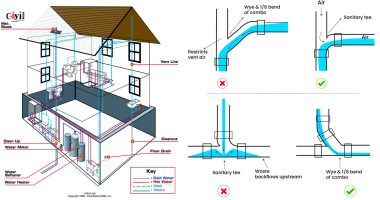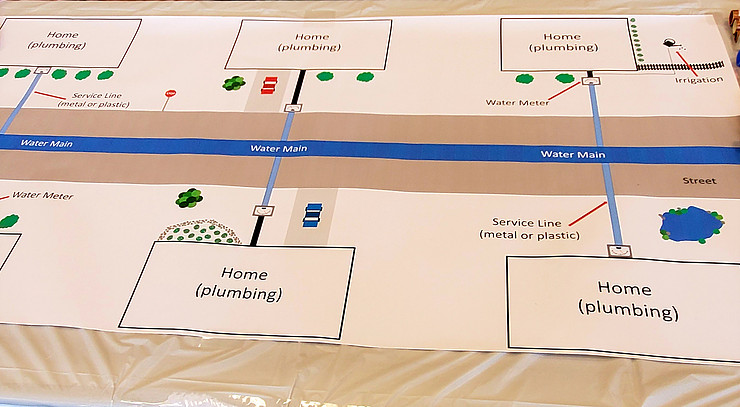In this article underneath you can find lots of superb information around Exploring Your Homes Plumbing Anatomy.

Understanding just how your home's pipes system functions is essential for each homeowner. From providing clean water for alcohol consumption, cooking, and showering to securely removing wastewater, a well-maintained pipes system is vital for your family's health and convenience. In this thorough overview, we'll check out the complex network that comprises your home's plumbing and deal tips on upkeep, upgrades, and managing typical problems.
Intro
Your home's pipes system is greater than just a network of pipelines; it's an intricate system that guarantees you have access to clean water and efficient wastewater elimination. Recognizing its parts and exactly how they work together can aid you protect against costly repairs and make sure everything runs smoothly.
Fundamental Components of a Pipes System
Pipes and Tubes
At the heart of your pipes system are the pipelines and tubing that bring water throughout your home. These can be made from numerous materials such as copper, PVC, or PEX, each with its advantages in terms of durability and cost-effectiveness.
Fixtures: Sinks, Toilets, Showers, etc.
Fixtures like sinks, bathrooms, showers, and bath tubs are where water is used in your home. Comprehending exactly how these components attach to the pipes system aids in detecting troubles and planning upgrades.
Valves and Shut-off Points
Shutoffs regulate the flow of water in your plumbing system. Shut-off valves are vital throughout emergencies or when you need to make repair services, permitting you to separate parts of the system without interfering with water circulation to the entire house.
Supply Of Water System
Main Water Line
The primary water line links your home to the metropolitan water supply or a private well. It's where water enters your home and is distributed to various fixtures.
Water Meter and Pressure Regulatory Authority
The water meter actions your water use, while a pressure regulator guarantees that water streams at a risk-free stress throughout your home's pipes system, protecting against damages to pipes and fixtures.
Cold Water vs. Warm water Lines
Recognizing the distinction in between cold water lines, which supply water directly from the main, and hot water lines, which carry warmed water from the hot water heater, helps in troubleshooting and preparing for upgrades.
Drain System
Drain Pipes and Traps
Drain pipes carry wastewater far from sinks, showers, and commodes to the sewage system or septic system. Catches protect against sewage system gases from entering your home and additionally trap debris that could trigger obstructions.
Air flow Pipelines
Air flow pipes allow air right into the water drainage system, protecting against suction that could slow down drain and cause traps to vacant. Correct ventilation is necessary for preserving the honesty of your plumbing system.
Importance of Correct Drainage
Making sure correct drain stops back-ups and water damage. Consistently cleaning up drains and preserving catches can prevent costly repairs and prolong the life of your pipes system.
Water Heater
Sorts Of Hot Water Heater
Water heaters can be tankless or conventional tank-style. Tankless heaters warm water on demand, while tanks save warmed water for prompt use.
Upgrading Your Plumbing System
Factors for Updating
Updating to water-efficient fixtures or changing old pipes can enhance water top quality, minimize water bills, and raise the worth of your home.
Modern Plumbing Technologies and Their Benefits
Discover technologies like smart leak detectors, water-saving commodes, and energy-efficient hot water heater that can save cash and minimize ecological impact.
Price Factors To Consider and ROI
Calculate the in advance costs versus long-term financial savings when thinking about pipes upgrades. Many upgrades spend for themselves with reduced energy bills and less repair services.
Exactly How Water Heaters Link to the Pipes System
Recognizing exactly how water heaters attach to both the cold water supply and hot water circulation lines helps in detecting problems like not enough warm water or leakages.
Upkeep Tips for Water Heaters
Frequently flushing your water heater to get rid of sediment, checking the temperature level settings, and examining for leakages can extend its life-span and improve power effectiveness.
Typical Plumbing Concerns
Leakages and Their Reasons
Leakages can take place because of aging pipes, loosened installations, or high water pressure. Attending to leakages immediately protects against water damage and mold and mildew development.
Clogs and Obstructions
Blockages in drains pipes and commodes are frequently triggered by purging non-flushable products or an accumulation of oil and hair. Utilizing drainpipe screens and being mindful of what decreases your drains can protect against clogs.
Signs of Pipes Problems to Watch For
Low tide pressure, sluggish drains pipes, foul odors, or unusually high water bills are signs of potential pipes issues that should be attended to immediately.
Plumbing Maintenance Tips
Normal Examinations and Checks
Arrange yearly plumbing assessments to capture issues early. Try to find indications of leaks, rust, or mineral buildup in faucets and showerheads.
DIY Upkeep Tasks
Easy jobs like cleansing faucet aerators, checking for commode leakages making use of color tablet computers, or insulating revealed pipes in cool climates can protect against significant pipes problems.
When to Call a Specialist Plumbing
Know when a pipes issue requires expert know-how. Trying complex repair work without correct understanding can result in more damages and greater fixing prices.
Tips for Reducing Water Usage
Simple practices like taking care of leakages without delay, taking much shorter showers, and running complete tons of washing and meals can preserve water and reduced your energy costs.
Eco-Friendly Pipes Options
Think about sustainable plumbing products like bamboo for floor covering, which is durable and green, or recycled glass for counter tops.
Emergency situation Preparedness
Actions to Take During a Plumbing Emergency
Know where your shut-off valves lie and just how to turn off the water system in case of a burst pipeline or major leak.
Significance of Having Emergency Contacts Helpful
Maintain call info for local plumbings or emergency situation solutions readily offered for quick reaction during a pipes dilemma.
Environmental Influence and Conservation
Water-Saving Fixtures and Home Appliances
Installing low-flow faucets, showerheads, and commodes can significantly decrease water usage without giving up efficiency.
DIY Emergency Situation Fixes (When Applicable).
Short-term repairs like making use of air duct tape to spot a dripping pipeline or putting a container under a leaking tap can reduce damage until a professional plumbing technician shows up.
Final thought.
Recognizing the makeup of your home's pipes system equips you to preserve it successfully, saving time and money on repairs. By following routine upkeep regimens and remaining notified about modern plumbing modern technologies, you can guarantee your pipes system operates effectively for years to come.
HOW YOUR PLUMBING SYSTEM WORKS
Which Pipes Do What?
Blue lines = fresh water supply entering the building Red lines = hot water supply entering the building Grey lines = pipes carrying waste away from the building and venting pipes carrying gases away from the building (through the roof) YOUR MAIN PLUMBING SYSTEMS
There are two main plumbing systems that support your home s basic plumbing needs one that brings clean water into your home, and one that sends dirty water away from your home. Connected to the toilet, bath, shower, and other faucets in your home, these two systems keep your water flowing in the right directions.
ACCESSING FRESH WATER
Fresh and clean water is brought into your home through the main water supply line . Filtered through one pipe, this water is pressured to flow into the various fixtures in your home at any given time.
This water can be sourced from a well located on your property, a pond or river (mostly cottages), or, as in most cases, from the city s municipal water treatment centre. However, it is important to note that water that is untreated, such as the water siphoned from ponds or rivers, may not be safe to drink. Personal water supplies always need to be treated for hardness and contaminants before consumed.
MUNICIPAL WATER SUPPLIES
Improve taste and odour Remove sediment Eliminate hardness Reduce chlorine COLD WATER SUPPLY VS. HOT WATER SUPPLY
Cold water flows into your home or building through the service line, which then distributes hot or cold water to your fixtures. This line is most commonly run through a central column that runs floor to floor. Hot water runs in short and straight pipes as the longer the pipeline, the more heat that will be lost in the transfer. Having shorter pipes also allows residents to access hot water more quickly.
WASTE WATER SYSTEM
Your wastewater system is divided into two parts pipes that send wastewater away from your home and venting pipes that send sewer gas away from your home. Sewage water travels through pipes that flush the water and waste towards local sewers that are operated and managed by your city or town. Most sewer systems rely on gravity to move the wastewater to where it needs to go.
The further away from your toilet or sink, the larger wastewater pipes become. This allows for waste to be disposed of from various parts of your home or business at once without pipe blockages. The angle and flow of these pipes are also essential for keeping your waste pipes clear of build up.
https://harrisplumbing.ca/how-your-home-plumbing-system-works/

Hopefully you enjoyed our piece on Understanding Your Home's Plumbing Anatomy. Thanks so much for spending some time to browse our content. Appreciated our blog entry? Please quickly share it. Let another person discover it. Thank-you for going through it.
Visit My Site